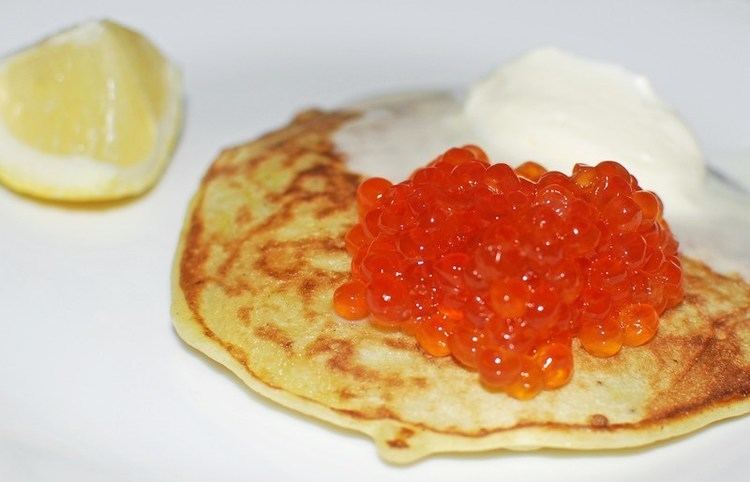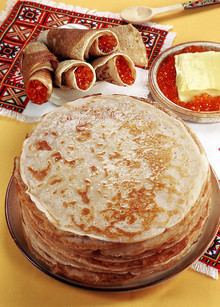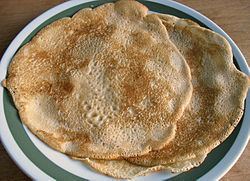Alternative names Blin, bliny, blintchik Main ingredients Buckwheat | Type Pancake Main ingredient Buckwheat | |
 | ||
Similar Crêpe, Caviar, Pelmeni, Smetana, Potato pancake | ||
Russian style cooking blini the russian pancakes easy but super tasty crepes recipe
A blini (sometimes spelled bliny) or, rarely, blin (more accurate as a single form of the noun) is a thin pancake, traditionally made from buckwheat flour and served with sour cream, butter, caviar, and other garnishes. Should not be confused with blintzes ("blinchik" in Russian) also known as crepes or palatschinke.
Contents
- Russian style cooking blini the russian pancakes easy but super tasty crepes recipe
- How to make blini russian pancakes recipe
- Etymology
- Overview
- Varieties
- References

Some English dictionaries record usage of the forms blin as singular and blini or bliny as plural, which correspond to the originally Russian forms, but some dictionaries consider this usage so rare in English that they do not mention blin at all and only record the widespread modern regular usage of blini for the singular and blinis for the plural, for example the American Heritage, MacMillan, and Vocabulary.com dictionaries. Some cookbooks and restaurants use blin and blintchick as in Russian to refer to crêpes.

Blintzes are apparently an offshoot (an evolved or variant form) of blini. They are thin pancakes usually made of wheat flour (not buckwheat), folded to form a casing (as for cheese or fruit) and then sautéed or baked.

How to make blini russian pancakes recipe
Etymology

Blini comes from the Russian word блины́ bliný (plural of блин blin), which refers to pancakes in general and comes from the Old Russian mlinŭ, blinŭ, which comes from Old Slavic mlinъ, (cf. млинець (mlynets’), Ukrainian for blin).
Overview

Blinis were considered by early Slavic people in pre-Christian times to be a symbol of the sun, due to their round form. They were traditionally prepared at the end of winter to honor the rebirth of the new sun (Butter Week, or Maslenitsa, also called "pancake week"). This tradition was adopted by the Orthodox church and is carried on to the present day. Blini were also served at wakes to commemorate the recently deceased.
Traditional Russian blinis are made with yeasted batter, which is left to rise and then diluted with cold or boiling water or milk. When diluted with boiling water, they are referred to as zavarniye bliny. Traditionally, blinis are baked in a Russian oven. The process of preparing blinis is still referred to as baking in Russian, even though they are nowadays pan-fried, like pancakes. French crêpes made from unyeasted batter (usually made of flour, milk, and eggs) are also common in Russia. All kinds of flour is used, from wheat and buckwheat to oatmeal and millet, although wheat is currently the most popular.
Blinis were popularized in the United States by Eastern European Jewish immigrants who used them in Jewish cuisine. While not part of any specific religious rite in Judaism, blinis stuffed with a cheese filling and then fried in oil are served on holidays such as Chanukah (as oil played a pivotal role in the miracle of the Chanukah story) and Shavuot (when dairy dishes are traditionally served within the Ashkenazi minhag). Blinis, also called "blinchiki" in Russian, are ordinarily stuffed before frying a second time. Fillings include chocolate, mushrooms, meat, rice, mashed potatoes, and cheese.
Varieties
Some ways that blinis are prepared and served include the following:
Blinis are the traditional meal in Lithuania on Fat Tuesday.
